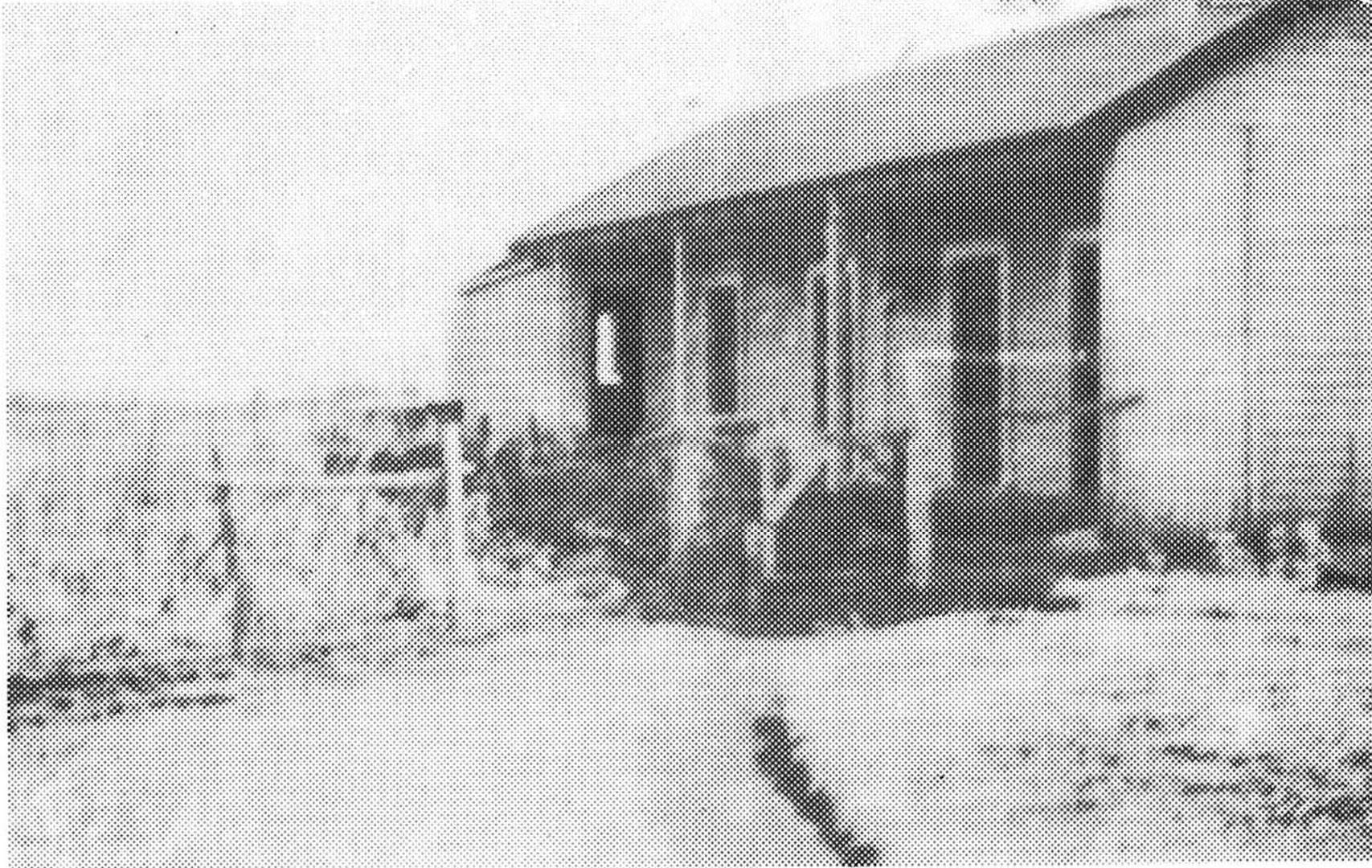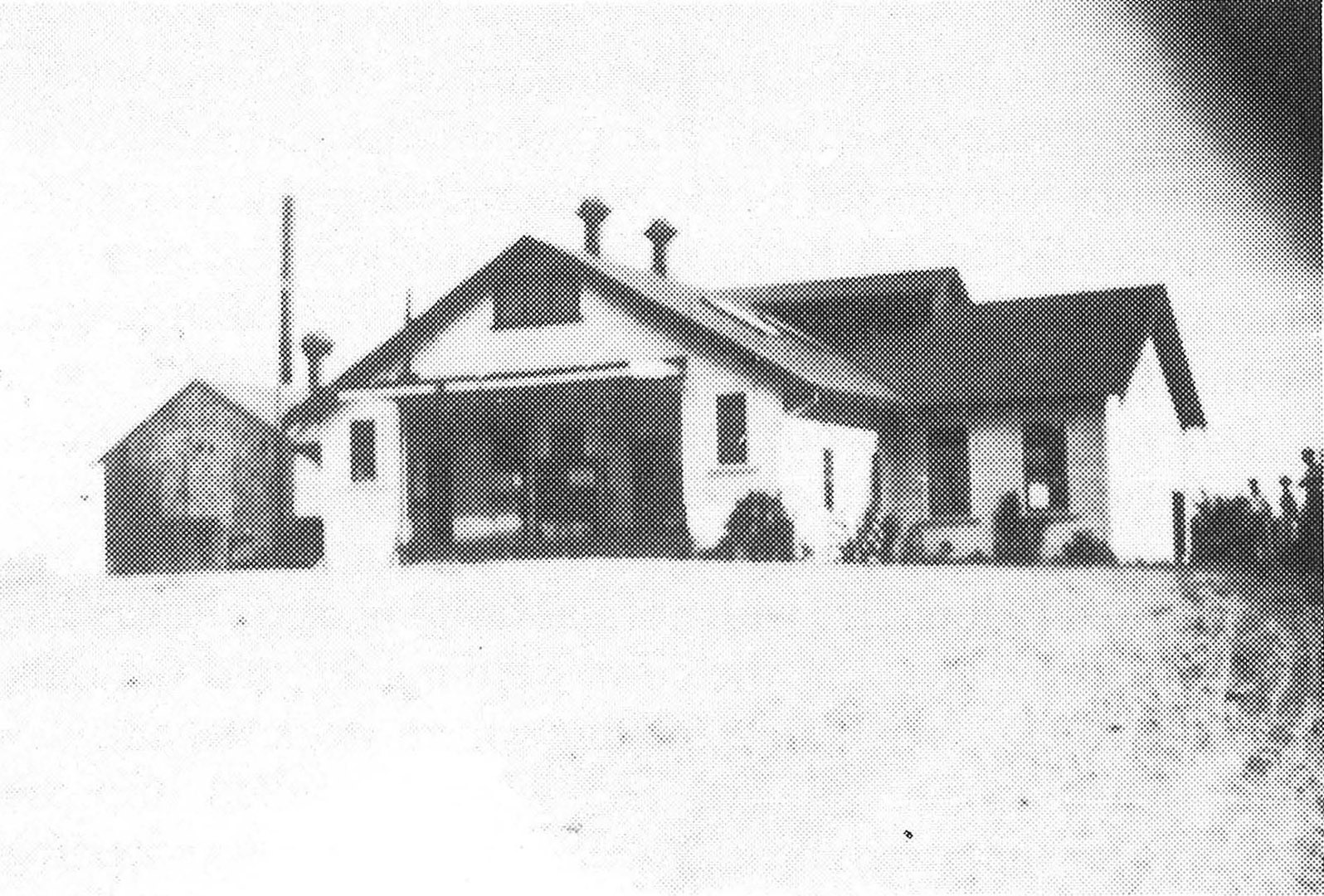
LIKE the mythical phoenix, the Eureka Butter Factory has continued to rise anew since 1903. It has weathered several fires, different owners-even bullet holes! Today it sits on a farm in Eureka, its role much altered from its earlier function. Over the years it has been a butter factory, cheese factory, produced hay barns and chips and was a depot for a transport company! Originally operated by the New Zealand Loan and Mercantile Agency Company it was first called the Eureka Co-operative Dairy Company and owned eight hectares at Eureka. From 1903 on it churned out butter under its own name: Eureka.1
The Eureka company also owned a creamery at Tauwhare which it operated till 1917 when it sold part of the four hectare property to Mr William Edward Jones.2 The company still retained two hectares until the early twenties.
In the pioneering stage of the dairy industry, farmers delivered their wholemilk to a nearby creamery where it was separated and the cream was then carted to a centralised factory for butter manufacture. This may have been the case at Eureka. In 1909 there were 28 suppliers to the skimming station at Tauwhare. By 1915 there were 38, falling away to 25 by 1917.3 From 1909 many farmers took up "home separation", separating the milk on the farm and some sent their cream by rail to the factories at Frankton or Morrinsville.
The Eureka Butter Factory was situated on Hunter Road, then called Factory Road. The first building was made of wood and was managed by Mr William George Jackways. He was succeeded by Mr Ken Campbell. Mr Jack Falconer was manager between 1911 and 1918. Five Falconer children went to the school: Alice, Frances, Mace, Reid and Herbert.
Dairying then was not the specialised industry it is now. Times were hard and the revenue gained from supplying milk helped to boost the struggling farmer's income. Milking was not allowed to interfere with normal farming operations. The family was up at 4 am, the cows were milked and the milk taken to the factory before the day's farm work began.
A steady stream of carts and waggons pulled into the factory in the mornings. The daily trip was a meeting point-a chance to tell a tall tale or exchange a joke. Then there were races home down the Old Factory Road.
Contraptions used then were often dangerous, not only to the driver but to others on the road, too. Mr Billy Field, a settler of Friedlander Road, was a familiar sight on Station Road riding on his spring cart pulled by a faithful old horse.
As he sedately made his way down the road to the station with his cream, the wheels would suddenly come apart, the cream cans clattering off the cart.
The spokes on the wooden wheels were notorious as they used to dry and shrink in the summer.4
When the milk was unloaded it was sampled, graded and weighed. Each farmer received the whey from the milk he supplied. Pigs were reared on most farms as the whey was fed to them and they provided an extra source of income. Hence the label "butter and bacon factories". In 1907 the factory was gutted by fire and the farmers took their milk to Tauwhare while the new factory was being built.
On a blustery spring day the new Eureka Butter Factory was opened by the Member for the district, Mr Greenslade .5 Almost 300 settlers attended the opening held on September 8, 1909. The brick building erected on the old site contained a separating room, manufacturing room, insulated chamber and engine room. It was built by J. T. Julian and Company and cost 200 pounds. With all the new equipment the factory's output was expected to reach 152 tonnes of butter.
A patent American hoist was erected behind the milk shed -the first of its kind in New Zealand and the engine, boiler and refrigerator were thoroughly overhauled.
By 1918 this factory was run by the New Zealand Dairy Association.6 The NZDA operated on the basis of its creamery stations some of which supplied the Eureka Factory. Cream was brought to Eureka from Matangi, Orini, Gordonton and other nearby districts. In 1919 the major dairy companies in the South Auckland area amalgamated and formed the New Zealand Co-operative Dairy Company which ran the Eureka Factory till it shut down.
Some of Eureka's inhabitants had contracts to cart butter from the factory to the station. Mr George Hinton had the job for a while. Each day, laden with butter containers, he headed off down Station Road. Flanked by wide drains, the road was often boggy. On odd occasions the drays became stuck in the mud. Mr Hinton's method of extricating them was simply to throw a few containers over the side. The load lightened, they proceeded on.
The demise of the factory came in 1921-again destroyed by fire. Only the shell remained which a local farmer used as a storage shed. But by 1923 another building was erected on the site: a cheese factory. In the meantime the farmers had taken their milk to Matangi.
Tenders were called for the metalling of the road leading to the rise on which the new factory was to be built. Mr John Hooper was given the contract.
The Hooper family shifted to Eureka in 1920 and settled in Hooper Road. They started a carting business in the twenties which grew to become Eureka Transport, a family concern untill980.
With a dray borrowed from a friend, and two horses, Mr Hooper carted the metal from the station to the site. It was shovelled on by hand and he was paid four shillings and six-pence a yard. W. B. Young of Hamilton won the contract for building the factory; Mr Hooper carted the timber and shingle from the station. He also put down a bore for the water used at the factory. 7
The cheese factory comprised portions of the former Eastport Road factory, which was situated in the Waitoa area. It was then the Thames Valley Co-operative Dairy Company.8 It came by rail to Eureka and was reassembled and joined onto the old shell of the butter factory. The cheese factory was the 16th built by the company and cost 5500 pounds. It was equipped with vats, a regenerative pasteuriser, cooler, milk weigher, agitator and whey separator. In its first season it was supplied with milk from 1000 cows and this increased to 1800.
Before 9 am each day the farmers arrived with their 30 gallon cans of milk.
The cans were slid onto the landing stage and the contents tipped into the vats. Often the horses bolted onto neighbouring farms with the farmers in hot pursuit.
The cheese-making process took about eight hours and when the workers knocked off at five, the vats were scrubbed clean ready for the next day. The cheeses weighed about 36 kilos a block and were packed in crates and railed to Auckland.
The first cheese factory manager was Hugh Gilmer (1924-1928). He and Maggie had seven children-Nancy, Jean, Molly, Martin, Hughie, Thelma and Jessie-who all attended Eureka school.
Mr Cuthbert Cresswell was the second manager and the family resided at Eureka from 1928 till l942. Six workers were also employed and they lived in a cottage on the factory grounds.
The Cresswell kids-Henry, Clarry, Jessie, Athol, Donald and Billy-are well-remembered in the community for their antics and pranks. They spent many happy hours fooling around the factory sticking their fingers in the cheese and sampling the contents. On a hot day vats were handier than the Waitakaruru Stream. As they held 2700 litres of milk and were about a metre in depth the children filled them up with water and dived in.9
Athol Cresswell, one of the older children, had a burning ambition to be a pilot, so the vats served yet another purpose. Armed with a sheet he "flew" off the vats with his parachute -the short flight ended in the bushes. 10
However, the training paid off. During World War II Athol Cresswell became a night fighter pilot and flew over Germany in 1942. For his efforts he received a Distinguished Flying Cross.
The cheese factory also had its fair share of fires. In the summer of 1934-35 one of Mr. Cresswell's sons, Clary, headed back to Eureka after attending a dance at Motomaoho. The glow from the fire could be seen from quite a distance. As he neared Eureka around two a.m. he spotted the fire and tooted his horn. Quickly the taps were turned on and the vats filled with water. The farmers rallied round, formed a bucket brigade and finally put out the fire. It had been caused by the coal stored in the old butter factory catching alight by spontaneous combustion.
The settlers saved the company some 10,000 pounds. Their reward? Those involved received a pound each!11 During the Second World War cheesemaking became an essential industry and all farmers were directed to supply their nearest factory. The Eureka factory operated around the clock with a day and night shift.

Those who could not go to war served in the Home Guard. One of the factory hands became increasingly depressed that he could not join the soldiers. One night when the Home Guard was at rifle practice he comitted suicide at the factory -the bullet holes are still visible.
The factory finally closed in August 1945. The last manager was Bill McPartland. At first milk was taken to Matangi after collection from a dump opposite the store but later milk tanker collection took over.
The land and building was put up for auction in 1958 and was purchased by Mr Ted Hunter whose farm bordered the factory site. The building remained unused for some years and was then leased to Mr Johnny O'Neill for five years.
He built round hay barns at the factory. Today those barns can be seen dotted on various farms throughout the North Island. When he shifted out of the locality the building reverted to a farm storage shed.
In 1970 Mr Fife Anderson of Cambridge leased it and opened a potato factory. At first the factory pre-packed potatoes in ten pound bags. The business prospered and diversified. The building was renovated and soon goods trucks were pulling up at Eureka, off-loading tonnes of potatoes. Peeled potatoes, chips and the tiny round potatoes often served with meals on overseas flights on Air New Zealand were produced at the factory. By 1977 33 people were employed there. But after eight successful years Mr Anderson moved to Cambridge and the potato factory closed down.
Eureka Transport then bought the factory and used it as a depot but the family sold the business in 1980 and the building was regained by the Hunter family.
In 1981 it was again auctioned off and Maurice Torr purchased the site. The factory still sits on the site, sometimes used as a storage shed.
But it may yet again be given a new lease on life. Its present owner is toying with the idea of turning it into a country club!

